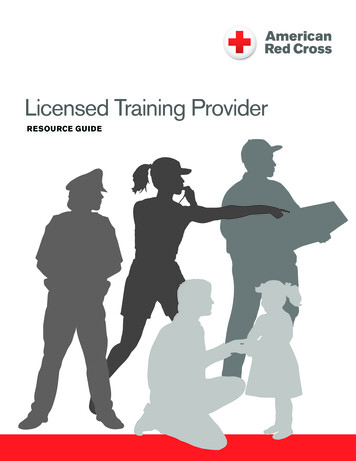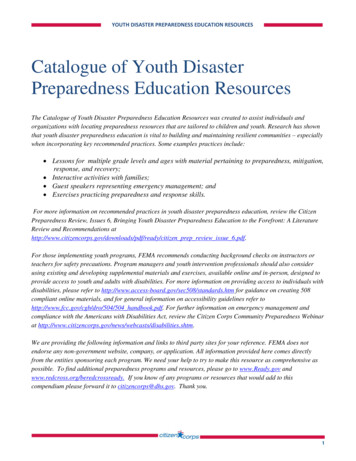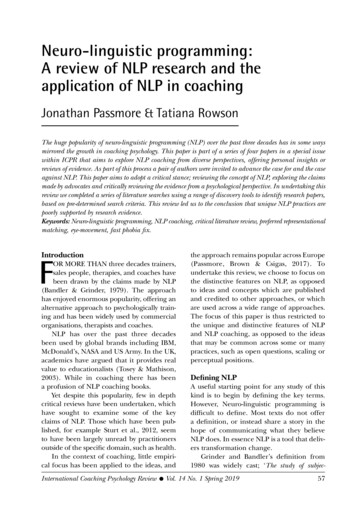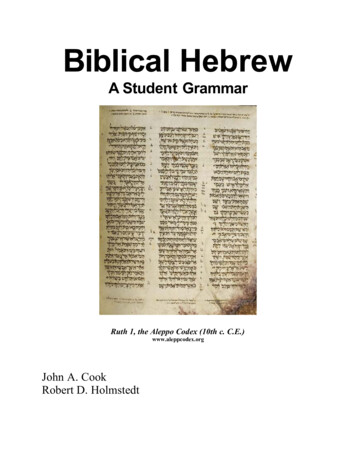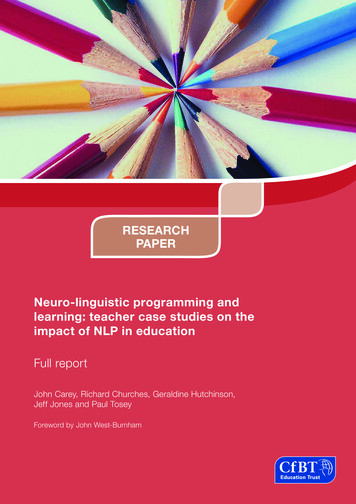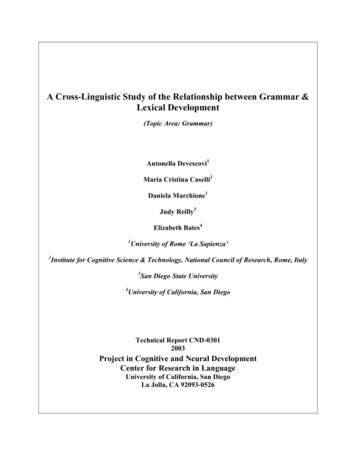
Transcription
A Cross-Linguistic Study of the Relationship between Grammar &Lexical Development(Topic Area: Grammar)Antonella Devescovi1Maria Cristina Caselli2Daniela Marchione1Judy Reilly3Elizabeth Bates412University of Rome ‘La Sapienza’Institute for Cognitive Science & Technology, National Council of Research, Rome, Italy34San Diego State UniversityUniversity of California, San DiegoTechnical Report CND-03012003Project in Cognitive and Neural DevelopmentCenter for Research in LanguageUniversity of California, San DiegoLa Jolla, CA 92093-0526
A Cross-Linguistic Study of the Relationship between Grammar & Lexical DevelopmentAbstractThe relationship between grammatical and lexical development was compared in 233 English and 233 Italian children between18 and 30 months of age, matched for age, gender, and vocabulary size on the MacArthur Communicative DevelopmentInventories (CDI). Four different measures of Mean Length of Utterance were applied to the three longest utterances reported byparents, and to corrected/expanded versions representing the ‘target’ for each utterance. Italians had longer MLUs on mostmeasures, but the ratio of actual to target MLUs did not differ between languages. Age and vocabulary both contributedsignificant variance to MLU, but the contribution of vocabulary was much larger, suggesting that vocabulary size may provide abetter basis for cross-linguistic comparisons of grammatical development. The relationship between MLU and vocabulary sizewas non-linear in English but linear in Italian, suggesting that grammar ‘gets off the ground’ earlier in a richly inflected language.A possible mechanism to account for this difference is discussed.Cross-linguistic studies have played a central rolein child language research for decades (Braine, 1976;Slobin (1985, 1992, 1997); MacWhinney & Bates,1989; Choi & Bowerman, 1991; Berman & Slobin,1994; Bates, Devescovi, & Wulfeck, 2001; Bowerman& Choi, 2001). As Slobin has pointed out repeatedly inhis own pioneering work on the topic, this is theresearch strategy that stands the best chance of helpingus to disentangle universal versus language-specificphenomena in language development. Through suchstudies, we have learned that children commit surprisingly few errors in the course of language learning(although the errors they do produce are quite informative — Slobin, 1985), that the content or concepts that1–2-year-olds try to express are remarkably similarfrom one language to another (negation, possession,location, disappearance, etc. — Braine, 1976), but thatvariations in the forms used by very young children toexpress these concepts are strikingly different from onelanguage to another (Demuth, 1990; Fortescue &Lennert Olsen, 1992). All these phenomena suggest thatchildren are conservative, ‘sticking to their input’ asthey figure out how to express a common stock of ideas(and some language-specific ideas as well — Choi &Bowerman, 1991; Bowerman & Choi, 2001).Despite these admirable advances in our understanding, serious methodological problems remain thatare acknowledged by virtually all researchers who engage in cross-linguistic research. One of the mostvexing problems is the establishment of equivalencebetween samples of children: When children from different language groups are compared to unveil similarities and differences, how shall they be matched?The simplest strategy is to match children by age, e.g.comparing the speech produced by 24-month-oldItalians with the speech produced by 24-month-oldchildren acquiring English. However, the variation thatcan be observed within any given language in this agerange is so vast (e.g. 24-month-olds can have virtuallyno speech at all, or they can display complex syntaxwith vocabularies of more than 600 words — Dromi,1987; Ogura, Yamashita, Murase & Dale, 1993; Fenson2et al., 1994; Caselli & Casadio, 1995; Caselli, Casadio& Bates, 1999; Maitel, Dromi, Sagi & Bornstein, 2000)that this strategy is necessarily risky. This is especiallytrue when the samples in question are small (as is oftenthe case in detailed longitudinal studies of free speech).In many years of comparative research on early language, attempts have been made to match childrenbased on length of utterance in content words or totalwords. However (as we shall also see below), thisstrategy does not guarantee a match in language level,since languages can vary in their ‘wordiness’ (e.g. thedifference between languages that do and do not permitomission of subjects and sometimes also objects in freestanding declarative sentences; variations over languages in the obligatory status of articles and otherfunctors). Attempts have also been made to matchbased on mean length of utterance in morphemes, butthis strategy raises a host of definitional issues aroundwhich no consensus has emerged, as evidenced by alively exchange on the Info-Childes mailing list (infochildes @mail.talkbank.org, as archived at h t t p : / /linguistlist.org). Indeed, the most successful and thorough efforts have typically been tailored to individuallanguages, with no attempt to generalize across languages (e.g. Dromi & Berman, 1982).In the present study, we will illustrate an alternative approach to the issue of cross-language matching. Recent studies have shown that, within a singlelanguage, vocabulary size is a more powerful predictorof grammatical development than age or gender, contributing significant variance to measures of grammarafter age and gender are controlled (Marchman &Bates, 1994; Bates & Goodman, 1997; Dale, Dionne,Eley, & Plomin, 2000). Studies in Italian, Japanese,Spanish and Hebrew have illustrated the same point(Caselli et al., 1999; Ogura et al., 1993; Jackson-Maldonado, Thal, Marchman, Bates & Gutierrez-Clellen,1993; Maitel et al., 2000). Taking advantage of thisfinding, we used the large norming data bases for theMacArthur CDI in two languages, English and Italian,to explore grammatical development and the relationship between vocabulary and grammar (controlling for
age and gender as well). To obtain estimates of structural complexity under different coding schemes, wecompared the three longest utterances reported byparents for 466 children (233 Italian; 233 English),matched for age, gender, and vocabulary size on theMacArthur CDI for each language. For each reportedutterance, a corrected version is constructed in whicherrors are corrected and (by conservative criteria) obligatory elements are restored (e.g. from ‘Kitty sleeping’to ‘The kitty is sleeping’). This will permit us tocompare the distance between actual and ‘target’ (attempted) constructions in each language. Four differentmeasures of utterance length are applied to each actualand expanded utterance, yielding eight averages(MLUs) for each child. The four measures are designedto represent a continuum from a conservative estimatethat should differ minimally over languages (MLU incontent words) to increasing rich and complex measures of bound morphology. We want to stress that theset of possible morphological coding schemes is potentially infinite, and there is (as noted) no consensus onthe ‘right’ measure to use across languages. We havedesigned two morphological coding schemes that arelikely to reveal language differences. Both favor Italian(e.g. credit for gender agreement on modifiers, andmultiple aspects of verb morphology that are marked inItalian but not in English), but one allows for multiplecontrasts in pronoun choice that are marked in bothlanguages and may help English to ‘catch up’.The present study builds on two previous crosslinguistic studies by our research group comparingresults from the CDI norming data for English andItalian.The first of these (Caselli et al., 1995) focused onboth expressive and receptive vocabulary in the periodfrom 8 to 16 months, prior to the onset of grammar. Weexamined the relative proportions of nouns, predicates(verbs and adjectives), social words (games, routines,proper names) and function words at different ages, andat different levels of expressive and receptive vocabulary size. Similarities between languages far outweighed differences in this age range when childrenwere matched for total vocabulary size, including earlypredominance of common nouns and later appearanceof verbs and other predicates. However, we did findthat Italian children use a higher proportion of socialwords across this range of development compared withAmerican children acquiring English, reflecting culturaldifferences (including the tendency for extended families to live in the same city in Italy).The second study (Caselli et al., 1999) focused onboth expressive vocabulary and grammar in the periodfrom 18 to 30 months. Grammatical development wasassessed with a 37-item complexity scale comprisingpairs of sentences that vary in degree of complexity(e.g. ‘Kitty sleeping’ versus ‘Kitty is sleeping’). Parents3were asked to check the sentence within each pair that‘sounds more like the way that your child is talkingright now.’ Previous studies (Dale, Bates, Reznick &Morisset, 1989; Dale, 1991; Jackson-Maldonado et al.,1993; Marchman & Bates, 1994) have shown that thismeasure of grammatical complexity is highly correlatedwith Mean Length of Utterance in Morphemes based onfree-speech samples. When children were matched overlanguages for overall vocabulary size, Caselli et al.confirmed an early predominance of common nounsand later onset of predicates, with no significant differences between languages in proportions of nouns orverbs at any point from 18 to 30 months. However, theycontinued to observe (as they had at a younger stage)higher proportions of social words in the Italian sample.There were also interesting differences in the shape ofdevelopment for function words as a proportion of totalvocabulary, reflecting continuous linear change inItalian from 50–600 words, versus non-linear growthin English (i.e. no change in proportions of functionwords from 0–400 words, but a marked accelerationafter 400 words).Caselli et al. (1999) found no differences betweenEnglish and Italian on the grammatical complexityscale when total vocabulary was controlled. Indeed, theshape of the strong non-linear growth function connecting grammatical complexity to total vocabulary sizewas identical in the two languages. This may seemrather surprising, given known differences betweenthese two languages in richness of inflectional morphology. However, the authors note that the complexityscales themselves are designed to discourage quantitative differences in the growth of grammar betweenthese two languages, because the scales in bothlanguages each contain exactly 37 items, designed toreflect grammatical structures that are known to occurin that language between 18 and 30 months. Tounderscore this point, Caselli et al. presented someinformal examples of the longest utterances reported byparents in a separate part of the CDI. When English andItalian children were matched for total vocabulary size,there appeared to be a marked advantage in grammatical complexity for the Italian children, in accord withthe well-known differences in complexity betweenthese two languages.The present study builds on the prior two byfocusing in much more detail on the three longestutterances reported by the parents of American andItalian children between 18 and 30 months. Weacknowledge from the outset that there is no substitutefor ‘live’ measures of free speech of the sort that areobtained in small-sample studies, and we present ourconclusions as working hypotheses for future studiesusing videotaped observations. However, we believethat results of the present study are provocative, and ofsufficient heuristic value to merit consideration despite
the limits of parental recall regarding the three longestutterances recently produced by their infants. Using thismethodology, we will address the following questions.(1) Within and across the four differentmeasures of structural complexity, will vocabularyaccount for more developmental variance thanchronological age?(2) When age, gender and vocabulary size arecontrolled, will there be an ‘Italian advantage’ instructural complexity, reflecting the greater morphological complexity of Italian compared with English? And if so, will this advantage be observedonly on MLU in morphemes, or will we find crosslinguistic differences in total words and/or contentwords?(3) Following on earlier reports by Caselli etal. (1999) for growth in function words, will wefind differences between English and Italian in theshape of change, reflected in non-linear growthpatterns for English (initially flat growth withsubsequent acceleration) and linear patterns forItalian?(4) When growth in structural complexity isevaluated in terms of the ratio of ‘complexityobtained’ (the actual utterance) versus ‘complexityattempted’ (the expanded/corrected versions), willthere be developmental and/or cross-linguistic differences in the proportion of attempted utterancesthat children are able to realize in their reportedspeech? Will we find a greater gap between actualand attempted speech in the richer inflectionalsystem of Italian, at least in the early stages? Orwill we see that children in each language are ableto express roughly the same proportion of theirtargets within and across levels of development,suggesting some kind of developmental constant inthe distance between effort and success (i.e. a kindof linguistic ‘zone of proximal development’)?MethodParticipantsParticipants were the parents of 466 childrenbetween 18 and 30 months of age, 233 in each language, 120 females and 113 males in each language,with reported expressive vocabularies on the MacArthur CDI ranging from 50 to 680 words. The childrenwere selected from larger norming samples for eachlanguage (Fenson et al., 1994; Caselli & Casadio,1995), including 618 Americans and 304 Italians forwhom parents had completed the Three LongestUtterances section of the CDI. To match children forthe purposes of the present study, we eliminated allchildren with vocabularies under 50 words (on theassumption, confirmed by direct inspection, that anyword combinations reported by parents were likely tobe frozen phrases). Because there were more American4than Italian children in the norming samples, we tookthe Italian children as the basis for comparison andsought, for each child, an American child of the samechronological age in months, gender, and approximatevocabulary size. This yielded the set of 233 children perlanguage used for all analyses below. A two-tailed t-testconfirmed that the two samples did not differ significantly in vocabulary size after matching.Groupings for analyses over age were determinedon the basis of chronological age in months (18 months,19 months, etc.). Groupings for analyses over vocabulary size followed precedents from our previous studies,as follows (eliminating children with vocabulariesunder 50 words): 50–100 words; 101–200 words;201–300 words; 301–400 words; 401–500 words;501–600 words; 600 words.MaterialsData for the English sample are based on the CDI:Words and Sentences (Fenson et al., 1993, 1994),designed for use with children in the 16–30-month agerange. This scale includes a 680-word vocabularyproduction checklist, organized into 22 semanticcategories (for details, see Fenson et al., 1993, 1994).Data for the Italian sample are based on the Words andSentences Scale for the Italian version of the MacArthur CDI (Caselli & Casadio, 1995). For the Italianversion of this scale, norms are available between 18and 30 months. The Italian word production checklistcontains 670 items, organized into 23 semanticcategories. The English and Italian versions of the CDIboth contain several different subscales designed tomeasure aspects of grammatical development, e.g. thegrammatical complexity checklist based on pairs ofsentences that vary in structural complexity. The grammar section of the CDI also has a final section that asksparents to write out the three longest sentences (each onseparate lines) that they can remember their childsaying in the last couple of weeks (on the grounds thatthese would be sufficiently recent and striking events tohave acceptable validity, similar to diary studies). Thislongest-utterance section furnished the speech samplesanalyzed in the present study.CodingClean-up. Prior to coding the longest utterancesreported by each parent, we first eliminated allutterances that were partially unintelligible, or wereobviously frozen phrases (taken from songs, prayers,counting, and other formulae). There were alsoinstances in which parents failed to write down threeseparate utterances. For those cases, and for those inwhich items had to be eliminated, all averages are basedon the total number of utterances available. For 82.8%of the children, averages were based on threeutterances. For 12.9%, averages were based on twoutterances, and for a small number of cases (4.3%) only
a single novel utterance was available for coding afterfrozen and/or partially unintelligible forms were removed.MLU coding schemes. Four different codingschemes for mean length of utterance were applied tothese data: in total content words, in total words (bothcontent and function words), in a conservative count oftotal morphemes (treating pronouns as single uninflected lexical forms), and in an expanded count of totalmorphemes (evaluating proforms along multiple dimensions).The distinction between total words and totalcontent words is not straightforward. In fact, there is noconsensus on the categorization of items into contentversus function words, and there are also cases in whichthe boundary of a single word is in question. To assureinter-rater reliability over languages, a series of ruleswere written to define content words and functionwords. For example, compound proper names (e.g.‘Santa Claus’) were treated as a single content word,but proper names that involve a potentially productiveelement (e.g. ‘Uncle Charlie’, ‘Uncle Fred’) weretreated as two content words. Pronouns, articles andquantifiers, prepositions, copulae and auxiliary verbswere treated as function words. Modal verbs weretreated as content words if they served as the main verb(e.g. ‘I want ice cream’) but as function words if theyserved as modals with another verb (e.g. ‘I want go’).Elided forms (e.g. ‘She’ll’ in English, or ‘della’ inItalian) were unpacked into two separate words (e.g.‘She will’ in English, and ‘di la’ in Italian) prior tocoding. A handful of high-frequency adverbial andadjectival forms (e.g. ‘very’) were treated as functionwords, with classifications made by agreement betweenraters.Matters become more complex as we moved fromword counts to morpheme counts. We began byattempting to construct a coding scheme that did notrequire assumption of any specific form as theunmarked form. Briefly put, this effort failed, bothwithin and between languages. Therefore, for eachlanguage, we established the unmarked forms fornouns, verbs, modifiers and (for the enriched pronouncount) pronominal forms. If the child produced theunmarked form only, a single morpheme was credited.For each marked contrast added to the item, anadditional morpheme was credited.For the conservative count of MLU in morphemes,rules were established that necessarily differ for Englishand Italian. English has a zero form for all nouns andverbs, which we chose as the unmarked form in allcases. This decision is further justified by the fact thatEnglish children tend to begin with the unmarked formof nouns and verbs in their early speech (with someinteresting item-based exceptions — Bloom, Lightbown& Hood, 1975; Tomasello, 1992). As is well known,5there are relatively few morphemes that can be added inEnglish, consisting almost entirely of plurals on nouns,and a handful of contrasts on verbs that are mutuallyexclusive (past tense, participial, third person singular,progressive). By contrast, Italian has no zero form fornouns or verbs. The singular-plural contrast for nouns ismarked syncretically (e.g. singular for boy is ‘ragazzo’while the plural is ‘ragazzi’). Verb markings are alsosyncretic rather than agglutinative, but several separatecontrasts can be marked simultaneously (e.g. ‘he/sheeats’ ‘mangio’; ‘they will eat’ ‘mangeranno’; ‘Iused to walk’ ‘mangiavo’). To capture these facts, thefollowing rules were established.— For nouns in both languages:unmarked singular no additional pointsmarked plural one additional point— For verbs in English:unmarked zero form no additional pointsmarked any non-zero form one additional point(i.e. 3rd person singular, progressive, past tense)— For verbs in Italian:unmarked 3rd person singular present no additional pointsmarked 1st or 2nd person one additional point plural one additional point any tense/aspect other than simple pres. one additional point— For modifiers in Italian:unmarked singular no additional pointsmarked plural one additional pointgender agreement (masc. or fem., modifiers only) one additional pointFor the conservative count, all pronouns (exceptmodifiers) were treated as single morphemes. Bycontrast, for the enriched/expanded count we also attempted to give credit for marked morphologicaldimensions on all proforms. This coding scheme willnecessary result in longer estimates than the conservative count, because it is cumulative. However,because English and Italian tend to indicate the samecontrasts on pronouns through lexical choice, thiscoding scheme provides an opportunity for Englishchildren to ‘catch up’ to some extent with their Italianpeers. The assumed unmarked proform was a nominative singular third-person pronoun in both languages.One additional point each was given for first- orsecond-person pronouns, for plural pronouns, and forany deviations from nominative case (accusative, genitive, dative). Hence the count for a single pronouncould range from one (‘he’ in English, ‘lui’ in Italian)to four (e.g. ‘ours’ in English, ‘nostri’ in Italian).Observed versus Expanded Utterances. Prior to theapplication of the above coding schemes, all utterances
were written in two forms: the original form reportedby the parent, and a form that was conservativelyexpanded/corrected to restore grammaticality, ifnecessary. So, for example, if a parent reported ‘Kittysleeping’, the expanded form would be ‘The kitty issleeping.’ We will refer to these two forms as‘observed’ and ‘attempted’, respectively, on theassumption that the corrected form represents thechild’s target, whereas the observed form representsthat portion of the target that the child was able torealize in his/her speech. The four coding schemesdescribed above were applied to both the observed andattempted form of every utterance, resulting in eightscores for each child, plus an additional four scoresrepresenting the ratio of observed to attempted for eachcoding scheme. To illustrate the latter, the ratio of‘Kitty sleeping’ to ‘The kitty is sleeping’ would be 2/4(50%) in total words and 3/5 (60%) in total morphemesby the conservative count. The idea behind thecorrected codings was to assess, for each codingscheme and for each language, whether there aredevelopmental or cross-linguistic changes in theproportion of their presumed target utterances thatchildren are able to produce.Appendix I provides examples of observed andexpanded utterances at each vocabulary level, for eachlanguage. For each of these utterances, illustrativescores are provided in Appendix I for each utterance,for each of the four coding schemes.Results and DiscussionResults will be presented in an order that reflectsthe four main questions posed in the introduction.(1) Does vocabulary predict growth better thanage?We first addressed this question with two omnibusmixed analyses of variance: one for Language by AgeGroup by Coding Scheme, with age and language asbetween-subjects variables and coding scheme as awithin-subjects variable; another for Language byVocabulary Size by Coding Scheme, with age andvocabulary size between-subjects and coding schemewithin-subjects. All within-subjects effects are Greenhouse-Geiser corrected.In the analysis over age, there were significantmain effects of all three variables (Language, F(1, 440) 8.58, p 0.004; Age, F(12, 440) 13.99, p 0.0001;Coding Scheme, F(3, 1320) 456.28, p 0.0001). Thecoding scheme effect was inevitable, given thecumulative nature of the four measures, and the ageeffect reflects an unsurprising increase in complexitywith age. The language effect reflects an overalladvantage for Italian. In addition, there were twosignificant two-way interactions: Code by Language(F(3, 1320) 19.81, p 0.0001) and Code by Age6(F (36, 1320) 11.22, p 0.0001). The Code byLanguage interaction reflects a larger Italian advantageon the coding schemes that tap into morphologicalcomplexity. The Code by Age interaction reflectsbigger gains over time for the coding schemes thatinvolve inflections and function words. There was noLanguage by Age interaction (F 1.0), nor did thethree-way interaction reach significance, indicating thatage effects are parallel for English and Italian, despitethe overall Italian advantage in morphology. Althoughthe three-way interaction did not reach significance,Age by Coding Scheme effects are plotted separatelyfor English and Italian in Figures 1a–b, so that readerscan more easily examine the shape of developmentaleffects involving age, and compare them with thevocabulary size effects below.In the corresponding analysis of Language byVocabulary Level by Coding Scheme, all three maineffects again reached significance (Language, F(1 ,452) 14.38, p 0.0001; Vocabulary Level, F(6, 452) 56.40, p 0.0001; Code, (3,1356) 1035.24, p 0.0001), all in the predicted directions. There was nosignificant Language by Vocabulary interaction(F(6.452) 1.51, n.s.), indicating that changes tendedto occur in parallel across the two languages whenconflating over coding schemes. However, there weresignificant two-way interactions of Code by Language(F(3, 1356) 39.81, p 0.0001) and Code by Vocabulary Level (F(18, 1356) 46.79, p 0.0001), as well asa significant 3-way interaction (F(18, 1356) 2.10, p 0.04). To illustrate these effects, the Code byVocabulary Level interactions are plotted separately forEnglish and Italian in Figures 2a–b. In general, growthappeared to start earlier in Italian for the measuresinvolving inflections and function words. The conservative morpheme measure (pronouns treated as wholeforms) and the expanded morpheme measure (pronounsscores on multiple dimensions) appeared to differ morefor English, whereas the conservative morpheme measure and the measure in total words appeared to differmore for Italian. More detailed explorations of all theseeffects follow below, when we investigate the shape ofdevelopmental and cross-language effects within eachcoding scheme.Comparing Figures 1a–b for age and 2a–b forvocabulary size, it is evident at a glance that results arefar more regular and lawful when developmental effectsare plotted as a function of vocabulary size. Toinvestigate this more directly, with an emphasis onfinding out which of these developmental predictorsdoes a better job, we repeated the above two omnibusanalyses, covarying out the effects of vocabulary in theanalysis over age, and then covarying out the effects ofage in the analysis over vocabulary levels. When ageeffects were covaried out, the three-way relationship ofLanguage by Vocabulary by Coding Scheme remained
Figure 1a
Figure 1b
Figure 2a
Figure 2b
significant (F(18, 1353) 2.08, p 0.04), and the maineffect of vocabulary size remained strong (F(6, 451) 30.53, p 0.0001). In the corresponding analysis overage with vocabulary size (total number of words)covaried out, the 3-way interaction still failed to reachsignificance (F(36, 1370) 1.0, n.s.), and although themain effect of age remained significant (F(12, 439) 3.67, p 0.0001), it was relatively weak.In a final look at the relative predictive value ofthese two developmental measures, we also conductedregression analyses within each coding scheme, usingage, vocabulary size (in total words) as well as language as predictors. Results are summarized in Table 1.In all four analyses, the joint variance accounted for bythe three predictors was significant (p .0001), rangingfrom a low of 28.8% of the developmental variance forMLU in content words, to a high of 48.5% (almost halfthe variance) for the conservative measure of MLU inmorphemes. In all four analyses, significant uniquecontributions were observed for all three predictorswhen the other two were controlled. However, in everycase, vocabulary accounted for more than five times theamount of unique variance explained by age. We mayconclude that chronological age and size of vocabularyare both effective developmental predictors, and thatthey are partially independent in the variance that theyexplain. But vocabulary size is clearly a much strongerpredictor than age for all our measures of complexity.In all remaining analyses, we will concentrate onchanges over vocabulary levels rather than age, to learnmore about cross-linguistic differences in the natureand shape of changes in structural complexity.(2) Is there an Italian advantage?The omnibus analyses suggest that Italian childrendisplay a global advantage in the development of structural complexity, conflating across coding schemes.Furthermore, language interacts with coding scheme,suggesting that the Italian advantage may be greater formeasures involving inflectional morphology. To explore these cross-linguistic differences in more detail,we conducted separate Language by Vocabulary analyses of variance for each of the four coding schemes,with both language and vocabulary serving as betweensubjects variables. To simplify the text, statistical details of these analyses are presented in Tabl
A Cross-Linguistic Study of the Relationship between Grammar & Lexical Development Abstract The relationship between grammatical and lexical development was compared in 233 English and 233 Italian children between 18 and 30 months of age, matched for age, gender, and vocabulary size on t

